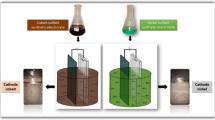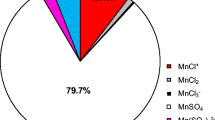Abstract
Results of beaker scale and large laboratory scale experiments on the deposition of manganese from chloride electrolytes are reported for conditions where chlorine is the secondary anode product.
Manganese concentration in the catholyte was found to be the most significant variable, with higher manganese levels (to 33 g Mn l−1) resulting in higher current efficiency (65–70%) and lower power consumption (5.5 kWh kg−1). Temperature (30–60°C) and current density (1.0–2.0 kAm−2) had opposing effects on current efficiency and power consumption. In the ranges studied, lower temperatures and higher current densities gave rise to increases in current efficiency and power consumption.
The literature on the electrowinning of manganese from chloride electrolytes is reviewed and the anomalies in previous reports discussed.
Similar content being viewed by others
References
T. J. George,South East Asian Iron and Steel Institute Quarterly 4 (1973) 31.
Z. Kulig,Giessereitechnik 16 (1970) 375.
K. Sugimoto,Nippon Kinzoku Gakkai Kaiho 10 (1971) 44.
K. Sugimoto, ‘Manganese Ores, Alloys, Metal and compounds: World Survey of Production, Consumption and Prices’, Roskill Information Services Limited, England, August 1972.
J. H. Jacobset al., U.S. Bureau of Mines R.I. 4817 (1951).
C. A. Hampel (Ed.), ‘The Encyclopaedia of Electrochemistry’, Reinhold Publishing Corporation, New York (1964).
V. N. Lisovet al., J. Appl. Chem. USSR 37 (1964) 1498.
E. V. Mulin and S. A. Zaretskii,Elektrokhim. Margantsa 3 (1967) 337.
W. W. Cooley and P. R. Lohnes, ‘Multivariate Data Analysis’, John Wiley and Sons, New York (1971) 168.
V. Aravamuthan and S. Gopal,Indian Mining J. 1 (1950) 5.
W. J. Sakowski, U.S. Patent 2, 810, 685, 22 October 1957.
Olin Mathieson, U.S. Paten 2, 798, 038, 2 July 1957.
C. M. Kooi and L. Louissen, Brit. Patent 1, 096, 979, 3 August 1966.
I. V. Gamaliet al., J. Appl. Chem. USSR 41 (1968) 2531.
S. A. Zaretskiiet al., ‘Electrochemistry of Manganese’, Vol 3, Akad. Nauk. Graz. SSR (1967) 239.
M. A. Qazi and J. Leja,J. Electrochem. Soc. 118 (1971) 548.
R. S. Dean, U.S. Patent 2, 798, 038, 2 July 1957.
R. S. Dean, U.S. Patent 2, 814, 591, 26 November 1957.
P. P. Yurev and V. M. Mozhaev,Tr. Leningrad Politekh. Inst. (1967) 272.
V. V. Stender and Yu. M. Loshkarev,J. Appl. Chem. USSR 36 (1963) 984.
R. I. Agladze (Ed.), ‘Electrochemistry of Manganese’, Izd. Akad. Nauk. Gruz. SSR, Tbilisi 1957.
Author information
Authors and Affiliations
Rights and permissions
About this article
Cite this article
Lewis, J.E., Scaife, P.H. & Swinkels, D.A.J. Electrolytic manganese metal from chloride electrolytes. I. Study of deposition conditions. J Appl Electrochem 6, 199–209 (1976). https://doi.org/10.1007/BF00616142
Received:
Issue Date:
DOI: https://doi.org/10.1007/BF00616142




